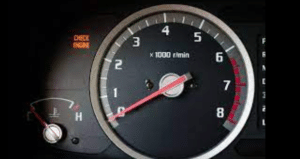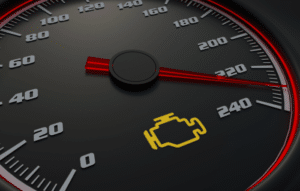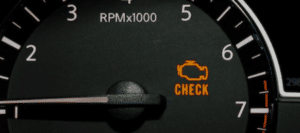Decoding the Check Engine Light: Understanding What Your Car is Telling You
The “check engine” light is a warning indicator on a vehicle’s dashboard that illuminates when the onboard diagnostic system detects a problem related to the engine or emissions system. This light can vary in appearance depending on the make and model of the vehicle but is typically depicted as an engine-shaped symbol. When the check engine light comes on, it’s important to address the issue promptly to prevent potential damage to the vehicle and ensure optimal performance.

Common Causes of a Check Engine Light:
- Loose Gas Cap: A loose or improperly tightened gas cap can cause the check engine light to illuminate. This is one of the most common and easily fixable reasons for the light to come on.
- Oxygen Sensor Malfunction: The oxygen sensor measures the amount of oxygen in the exhaust gases and helps regulate fuel mixture. A malfunctioning oxygen sensor can lead to reduced fuel efficiency and increased emissions.
- Faulty Mass Airflow Sensor: The mass airflow sensor measures the amount of air entering the engine and helps determine the proper air-to-fuel ratio. A faulty mass airflow sensor can cause engine performance issues and trigger the check engine light.
- Catalytic Converter Issues: The catalytic converter reduces harmful emissions by converting pollutants into less harmful gases. Problems with the catalytic converter, such as overheating or clogging, can trigger the check engine light.
- Ignition System Problems: Issues with the ignition system, such as faulty spark plugs, ignition coils, or wiring, can lead to misfires and trigger the check engine light.
- Exhaust Gas Recirculation (EGR) Valve Malfunction: The EGR valve recirculates a portion of the exhaust gases back into the engine to reduce emissions. A malfunctioning EGR valve can cause engine performance issues and trigger the check engine light.
- Fuel System Problems: Issues with the fuel system, such as a faulty fuel injector, fuel pump, or fuel pressure regulator, can lead to engine performance problems and trigger the check engine light.
Addressing a Check Engine Light:

When it comes on, it’s important to have the vehicle inspected by a qualified mechanic or automotive technician as soon as possible. They can use a diagnostic scan tool to retrieve trouble codes stored in the vehicle’s onboard computer, which can provide valuable information about the underlying issue.

Once the cause of the check engine light is identified, the technician can recommend the necessary repairs or maintenance to resolve the issue. Ignoring the check engine light can lead to further damage to the vehicle and potentially more costly repairs down the road.
The check engine light – that ominous glow on your dashboard that can strike fear into the hearts of even the most seasoned drivers. While it’s a common sight for many car owners, the check engine light remains one of the most misunderstood aspects of vehicle maintenance. In this comprehensive guide, we’ll delve deep into the check engine light phenomenon, exploring its causes, common fixes, and the importance of proactive maintenance.

Chapter 1: Understanding the Check Engine Light
In this chapter, we’ll provide an overview of what the check engine light is and how it functions. We’ll discuss its purpose as a warning indicator for potential issues related to the engine or emissions system. Additionally, we’ll explore the various shapes and symbols used to represent the check engine light in different vehicle makes and models.
Chapter 2: Common Causes of the Check Engine Light
Here, we’ll delve into the most frequent culprits behind a triggered it. From simple issues like a loose gas cap to more complex problems such as faulty oxygen sensors or catalytic converters, we’ll explore the wide range of potential triggers. Each cause will be explained in detail, including symptoms, diagnostic procedures, and potential consequences if left unaddressed.
Chapter 3: Diagnostic Tools and Procedures
In this chapter, we’ll discuss the tools and techniques used by automotive technicians to diagnose the root cause of a triggered check engine light. We’ll explore the role of diagnostic scan tools, onboard diagnostic systems (OBD-II), and trouble codes in identifying specific issues. Additionally, we’ll touch on the importance of proper training and expertise in interpreting diagnostic data accurately.
Chapter 4: DIY vs. Professional Repairs
Here, we’ll weigh the pros and cons of attempting to address a triggered that on your own versus seeking professional assistance. While some issues may be simple enough for DIY repairs, others may require specialized knowledge and equipment best left to trained technicians. We’ll provide guidance on when it’s appropriate to attempt DIY fixes and when it’s best to enlist the help of a professional mechanic.
Chapter 5: Maintenance and Prevention Strategies
In this final chapter, we’ll discuss the importance of proactive maintenance in preventing that issues. From regular oil changes and tune-ups to proper care of emissions components, we’ll outline essential maintenance tasks that can help keep your vehicle running smoothly and minimize the likelihood of triggering the check engine light. We’ll also address the importance of addressing warning signs promptly and scheduling regular inspections to catch potential issues before they escalate.
Conclusion:
It may seem intimidating, but armed with knowledge and understanding, it becomes a valuable tool for maintaining the health and performance of your vehicle. By familiarizing yourself with common causes, diagnostic procedures, and maintenance strategies, you can approach it with confidence and ensure that your vehicle remains in top condition for years to come. Remember, when in doubt, it’s always best to seek the expertise of a qualified automotive professional to address any concerns related to your vehicle’s check engine light.
The check engine light serves as an important warning indicator of potential issues with the engine or emissions system. Prompt attention to the light and timely repairs are essential to maintain the health and performance of the vehicle.